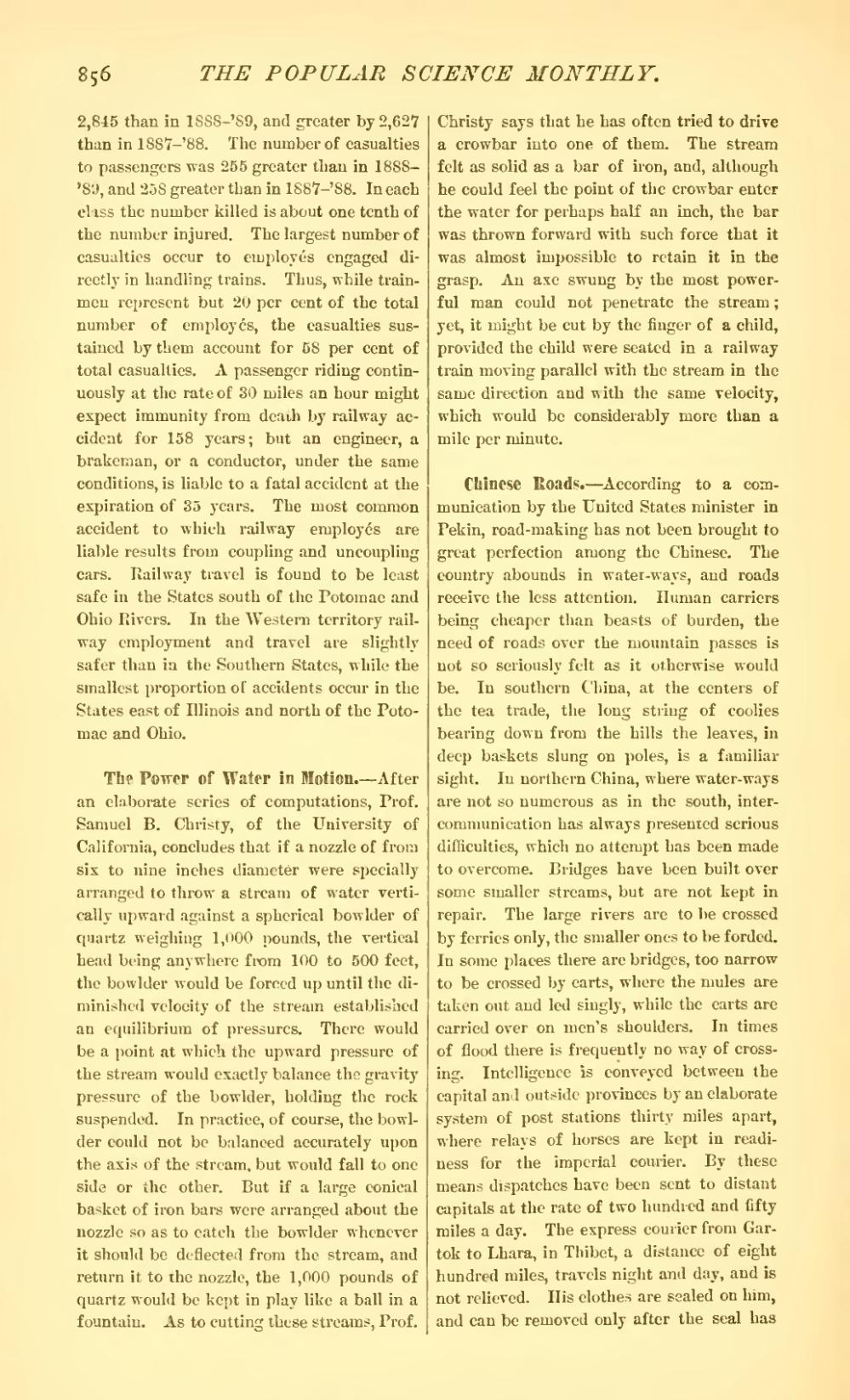2,845 than in 1888-'89, and greater by 2,627 than in 1887-'88. The number of casualties to passengers was 255 greater than in 1888'89, and 258 greater than in 1887-'88. In each class the number killed is about one tenth of the number injured. The largest number of casualties occur to employés engaged directly in handling trains. Thus, while trainmen represent but 20 per cent of the total number of employés, the casualties sustained by them account for 58 per cent of total casualties. A passenger riding continuously at the rate of 30 miles an hour might expect immunity from death by railway accident for 158 years; but an engineer, a brakeman, or a conductor, under the same conditions, is liable to a fatal accident at the expiration of 35 years. The most common accident to which railway employés are liable results from coupling and uncoupling cars. Railway travel is found to be least safe in the States south of the Potomac and Ohio Elvers. In the Western territory railway employment and travel are slightly safer than in the Southern States, while the smallest proportion of accidents occur in the States east of Illinois and north of the Potomac and Ohio.
The Power of Water in Motion.—After an elaborate series of computations. Prof. Samuel B. Christy, of the University of California, concludes that if a nozzle of from six to nine inches diameter were specially arranged to throw a stream of water vertically upward against a spherical bowlder of quartz weighing 1,000 pounds, the vertical head being anywhere from 100 to 500 feet, the bowlder would be forced up until the diminished velocity of the stream established an equilibrium of pressures. There would be a point at which the upward pressure of the stream would exactly balance the gravity pressure of the bowlder, holding the rock suspended. In practice, of course, the bowlder could not be balanced accurately upon the axis of the stream, but would fall to one side or the other. But if a large conical basket of iron bars were arranged about the nozzle so as to catch the bowlder whenever it should be deflected from the stream, and return it to the nozzle, the 1,000 pounds of quartz would be kept in play like a ball in a fountain. As to cutting these streams. Prof. Christy says that he has often tried to drive a crowbar into one of them. The stream felt as solid as a bar of iron, and, although he could feel the point of the crowbar enter the water for perhaps half an inch, the bar was thrown forward with such force that it was almost impossible to retain it in the grasp. An axe swung by the most powerful man could not penetrate the stream; yet, it might be cut by the finger of a child, provided the child were seated in a railway train moving parallel with the stream in the same direction and with the same velocity, which would be considerably more than a mile per minute.
Chinese Roads.—According to a communication by the United States minister in Pekin, road-making has not been brought to great perfection among the Chinese. The country abounds in water-ways, and roads receive the less attention. Human carriers being cheaper than beasts of burden, the need of roads over the mountain passes Is not so seriously felt as it otherwise would be. In southern China, at the centers of the tea trade, the long string of coolies bearing down from the hills the leaves, in deep baskets slung on poles, is a familiar sight. In northern China, where water-ways are not so numerous as in the south, intercommunication has always presented serious difficulties, which no attempt has been made to overcome. Bridges have been built over some smaller streams, but are not kept in repair. The large rivers are to be crossed by ferries only, the smaller ones to be forded. In some places there are bridges, too narrow to be crossed by carts, where the mules are taken out and led singly, while the carts are carried over on men's shoulders. In times of flood there is frequently no way of crossing. Intelligence is conveyed between the capital and outside provinces by an elaborate system of post stations thirty miles apart, where relays of horses are kept in readiness for the imperial courier. By these means dispatches have been sent to distant capitals at the rate of two hundred and fifty miles a day. The express courier from Gartok to Darchen, in Thibet, a distance of eight hundred miles, travels night and day, and is not relieved. His clothes are sealed on him, and can be removed only after the seal has

